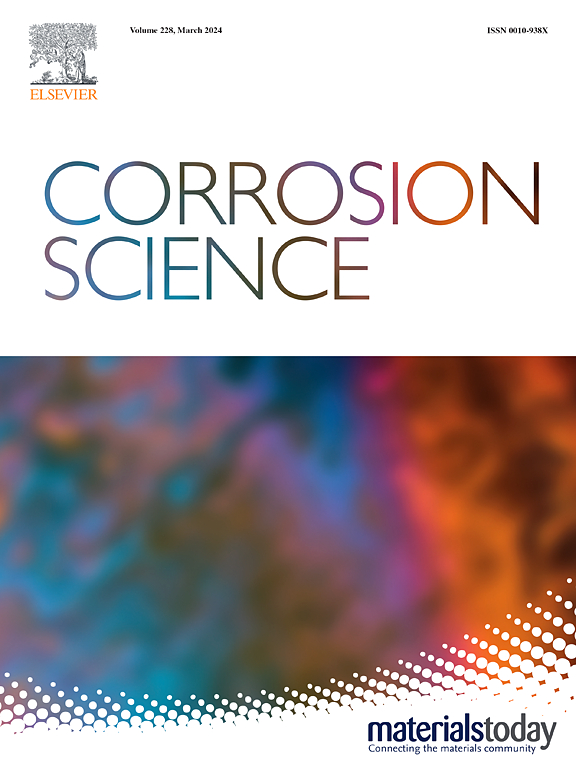Enhanced corrosion resistance of 2024 aluminum alloys with Cr2O3 thin layers by Atomic Layer Deposition
IF 7.4
1区 材料科学
Q1 MATERIALS SCIENCE, MULTIDISCIPLINARY
引用次数: 0
Abstract
This research explores the use of chromium oxide (Cr2O3) thin layers grown by Atomic Layer Deposition (ALD) as protective coating to enhance the corrosion resistance of 2024 aluminum alloys. In order to obtain sufficiently dense and uniform Cr2O3 layers, the ALD process was tailored in terms of alloy surface pretreatment before the main Cr2O3 ALD process. The corrosion resistance of both Cr2O3 coated and non-coated aluminum alloys was evaluated in a corrosive 0.1 M KOH environment using in situ optical microscopy and ex situ surface analysis techniques, including X-ray Photoelectron Spectroscopy (XPS) and Time-of-Flight Secondary Ion Mass Spectrometry (ToF-SIMS) and a neutral environment containing chlorides. Findings revealed that the Cr2O3-coated samples exhibited significantly reduced reactivity, highlighting the excellent corrosion protection provided by the Cr2O3 thin films. Although surface analysis revealed the presence of submicron defects within the Cr2O3 layer, which could act as corrosion initiation sites, the occurrence of these defects was mitigated with increasing Cr2O3 layer thickness. Additionally, after the corrosion test, an enrichment of copper and aluminum oxides at the layer surface was observed, suggesting preferential attack at intermetallic phases in corrosive environment.
原子层沉积法提高Cr2O3薄层2024铝合金的耐蚀性
本研究探讨了利用原子层沉积法(ALD)生长的氧化铬(Cr2O3)薄层作为保护涂层来提高2024铝合金的耐蚀性。为了获得足够致密和均匀的Cr2O3层,在Cr2O3 ALD主工艺之前对合金表面进行了预处理。使用原位光学显微镜和非原位表面分析技术,包括x射线光电子能谱(XPS)和飞行时间二次离子质谱(ToF-SIMS),以及含有氯化物的中性环境,在0.1 M KOH腐蚀性环境中评估了Cr2O3涂层和非涂层铝合金的耐腐蚀性。结果表明,Cr2O3涂层样品的反应活性显著降低,这表明Cr2O3薄膜具有良好的防腐性能。虽然表面分析显示Cr2O3层内存在亚微米缺陷,这些缺陷可以作为腐蚀的起始点,但随着Cr2O3层厚度的增加,这些缺陷的发生有所减轻。此外,在腐蚀试验后,观察到铜和铝氧化物在层表面富集,表明在腐蚀环境中优先攻击金属间相。
本文章由计算机程序翻译,如有差异,请以英文原文为准。
求助全文
约1分钟内获得全文
求助全文
来源期刊

Corrosion Science
工程技术-材料科学:综合
CiteScore
13.60
自引率
18.10%
发文量
763
审稿时长
46 days
期刊介绍:
Corrosion occurrence and its practical control encompass a vast array of scientific knowledge. Corrosion Science endeavors to serve as the conduit for the exchange of ideas, developments, and research across all facets of this field, encompassing both metallic and non-metallic corrosion. The scope of this international journal is broad and inclusive. Published papers span from highly theoretical inquiries to essentially practical applications, covering diverse areas such as high-temperature oxidation, passivity, anodic oxidation, biochemical corrosion, stress corrosion cracking, and corrosion control mechanisms and methodologies.
This journal publishes original papers and critical reviews across the spectrum of pure and applied corrosion, material degradation, and surface science and engineering. It serves as a crucial link connecting metallurgists, materials scientists, and researchers investigating corrosion and degradation phenomena. Join us in advancing knowledge and understanding in the vital field of corrosion science.
 求助内容:
求助内容: 应助结果提醒方式:
应助结果提醒方式:


